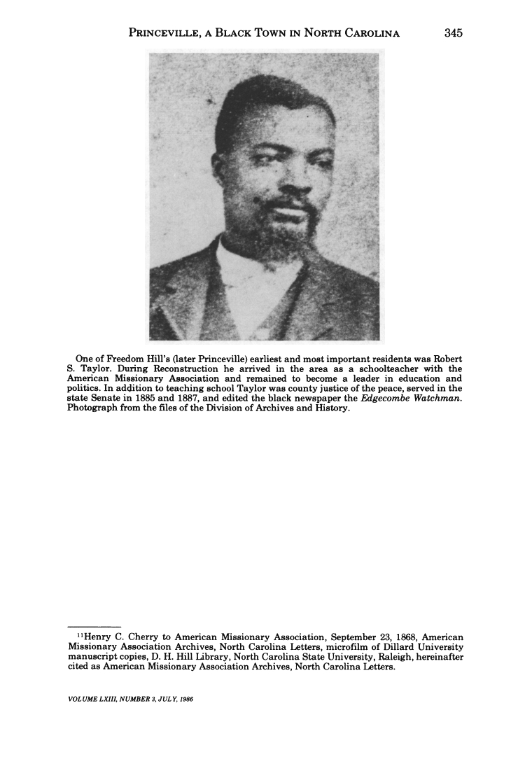
In the black village across the river from Tarboro, education gained a toehold in the first two
decades following the Civil War. An American Missionary Association (AMA) school for blacks was
organized in Tarboro soon after the war ended, but, as in other areas of the South, it was difficult to keep
northern teachers for long periods of time. Despite that difficulty, the blacks of Freedom Hill and
Tarboro remained anxious to continue schooling. In 1868, they urged black legislator Henry C. Cherry of
Tarboro to obtain a teacher for them. In September, Cherry wrote to the secretary of the AMA requesting
a teacher.
Susan Clapp, an AMA teacher in Plymouth, North Carolina, informed the secretary that the
freedman of Tarboro had a good schoolhouse and that the whites of the town and area generally favored
education for former slaves. 8
Clapp later recommended that a black teacher, Robert S. Taylor, be sent to
Tarboro to teach the freedmen. The AMA issued Taylor a certificate and assigned him to Tarboro. In
October 1870, Taylor wrote the AMA secretary requesting financial aid and reporting that he had thirty
students enrolled. After teaching in Tarboro for three years, Taylor settled in Freedom Hill where he continued to teach children and some adults. 9
The 1880 census lists him as one of six black school
teachers residing in Freedom Hill. He subsequently became one of the community’s most influential and
important leaders, serving as a county justice of the peace and two-term state senator. Education in
Freedom Hill received a considerable boost in 1883 when the community’s first public school, called the
Graded School, held classes. In the years to come the school made significant progress under the
leadership of a number of important black educators such as Taylor. 10 . . .. . . While residing in the black community Taylor became active in the Republican
Party and was elected a county justice of peace for five years. He then edited the Negro newspaper
Edgecombe Watchman in Tarboro. In 1885, he gained a seat in the state Senate and was reelected in
1887. There, as a former teacher, he labored hard to secure public support for black education. He also
served on committees for privileges, elections, and claims, and became a strong advocate for justice and
equal protection of the law for blacks in the state.
5 Tenth Census of the United States, 1880: Edgecombe County, North Carolina, Population Schedule pages 5-6 and
pages 39-42.
6
Rabinowitz, Howard N., Race Relations in the Urban South, 1865-1890 (New York: Oxford University Press),
pages 61-96. Rabinowitz has shown that the tendency for black men to be unskilled laborers and black women to be
laundresses or domestics also existed between 1865 and 1890 in southern cities such as Atlanta, Montgomery,
Nashville, Raleigh and Richmond. Much of what Rabinowitz has concluded about black economic structure in
those urban centers is applicable to Tarboro and Freedom Hill/Princeville.
7 Edgecombe County Census, 1880: Population Schedule pages 5-6 and pages 39-42.
8 Mobley, Princeville, A Black Town in North Carolina 1865-1915, pages 345-346.